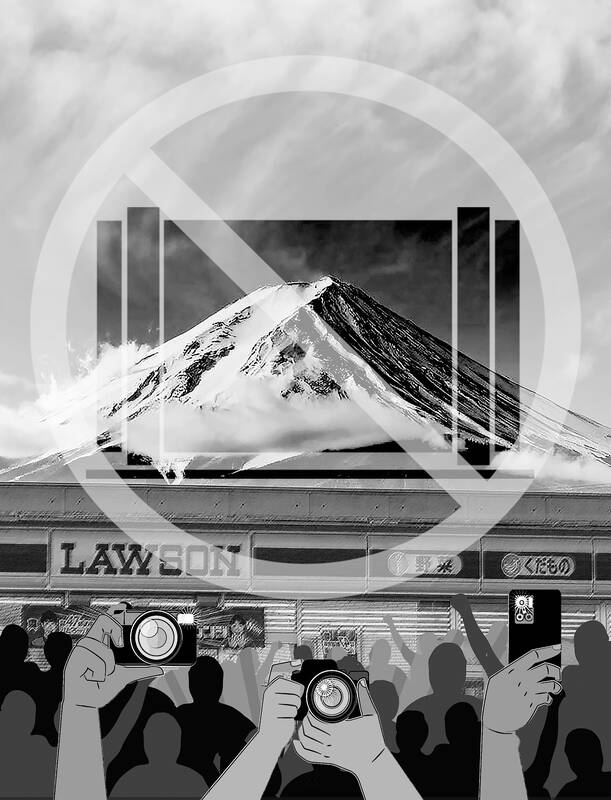The ukiyo-e artist Hokusai was famed for his Thirty-six Views of Mount Fuji, woodblock prints deeply symbolic of Japan — but one famous view of the mountain, this time from the modern era, has just been blocked off.
Local authorities in Fujikawaguchiko, a holiday town in the mountain’s shadow, this week erected a barrier obstructing a sight of the landmark that, from the right angle, made it appear to float above a convenience store in perhaps the ultimate illustration of traditional and modern Japan.
Although it might have been gold for Instagram, the rush of tourists was not appreciated by residents, who complained that visitors were littering, blocking access to services used by residents and spilling out dangerously onto the road in the quest for the perfect shot.

Illustration: Louise Ting
The end result: No one gets to enjoy the view. It is a solution to the problem that would make The Simpsons’ Mr Burns proud.
The government has been promoting the country to foreign visitors for years with immense success. Arrivals this year are expected to surpass the 2019 pre-COVID-19 record, travel agency JTB Corp said. Yet from increasingly unaffordable hotels to suitcase-clogged streets becoming nigh-unwalkable, the downsides are mounting for ordinary residents.
That dissatisfaction was articulated by one acerbic restaurant owner who last month took to social media to express mounting frustration with having to deal with tourists looking for English menus and service in their native language.
The time and hassle involved in dealing with them did not make sense for travelers who do not spend much anyway, the owner said.
The complaints split opinion, with some sympathizing, while others defended the country’s vaunted omotenashi — a word so synonymous with the Japanese welcome that it just made it into the Oxford English Dictionary (“good hospitality, characterized by thoughtfulness, close attention to detail, and the anticipation of a guest’s needs,” in case you were wondering).
However, just as in Fujikawaguchiko, that courtesy might be reaching its limits. Frustrated authorities and small-business owners are turning to new solutions to preserve their way of life. In Kyoto, where over-tourism is most acute, visitors have been banished from the backstreets of the geisha district of Gion (although it is unclear how this would be enforced), while the city is belatedly adding special buses for travelers amid complaints that elderly residents cannot access public transportation.
In Hiroshima, one restaurant serving the local soul food of okonomiyaki (coincidentally, another word just added to the dictionary) has declared visitors verboten on Friday evenings, limiting entrance to prefectural residents and regulars.
Part of the problem is that the pain of dealing with tourists is readily apparent, but the benefits — whether increased tax revenue or booming businesses — are often less visible. With about 40 percent of visitors traveling to Japan for the first time and social media pushing people to the same locations, some destinations are deserted, while others are well past capacity.
Especially with the yen trading at about ¥156 to the US dollar, foreigners can live like kings without spending that much. That exacerbates the frustration in a country where real wages have been stagnant for decades and are declining.
Many of the country’s iconic experiences, from the Mount Fuji convenience store to shooting video at Shibuya’s “Scramble Crossing,” simply do not cost any money.
Japan is far from alone in grappling with the issue. Barcelona has removed a bus route from map apps due to overcrowding. Venice just introduced a 5 euro (US$5.39) entrance tax during peak hours. Advocates in Mallorca have even erected fake signs in English, hoping to scare off vacationers by warning them of nonexistent dangers (an approach I am seriously considering imitating in Shibuya).
It is the pace of change where things are different. Countries such as Italy and Spain have had decades to get used to a tourist influx. Japan became one of the world’s most desired destinations practically overnight. The number of visitors to those European countries grew by about 20 percent between 2014 and 2019. In Japan, that figure more than doubled Of course, the former get two countries three to four times the absolute number.
Locals had only just started to get used to the arrivals when the unforeseen interregnum of COVID-19, reducing visitors to practically zero. Their sudden return has only intensified residents’ discontent.
Now the downsides keep stacking up. Hotel prices are surging, up 20 percent from last year, leaving some business travelers struggling to find lodging. Hotels are finding it relatively easy to raise prices to cope with a growing labor shortage in the services sector. Other industries that do not get a boost from tourist demand are not so lucky.
The country needs to grapple with these problems before over-tourism replaces omotenashi. The weak yen might be a tailwind now, but more than 30 million people still visited Japan in 2019 even with the currency closer to ¥100 to the dollar.
There are a couple of possible quick wins. The country charges a paltry ¥1,000 departure tax: That needs to be quadrupled or more. Ditto with the accommodation tax that some areas charge, including Tokyo, levied at only ¥100 to ¥200 per night.
Services only used by foreigners should impose much higher prices, such as the 70 percent increase levied last year on the Japan Rail Pass, a product only for tourists, which gives unlimited rides on the main Shinkansen line. The duty-free system, which exempts the 10 percent consumption tax for purchases of more than ¥5,000, has long since outlived its usefulness, with billions of yen being lost to scalpers. The system should be scrapped or the minimum spend hugely increased.
Ultimately, these are short-term solutions to make putting up with the pain a little easier. Japan needs fixes better than simply blocking everything off.
Gearoid Reidy is a Bloomberg Opinion columnist covering Japan and the Koreas. He previously led the breaking news team in North Asia, and was the Tokyo deputy bureau chief. This column does not necessarily reflect the opinion of the editorial board or Bloomberg LP and its owners.

On Sept. 3 in Tiananmen Square, the Chinese Communist Party (CCP) and the People’s Liberation Army (PLA) rolled out a parade of new weapons in PLA service that threaten Taiwan — some of that Taiwan is addressing with added and new military investments and some of which it cannot, having to rely on the initiative of allies like the United States. The CCP’s goal of replacing US leadership on the global stage was advanced by the military parade, but also by China hosting in Tianjin an August 31-Sept. 1 summit of the Shanghai Cooperation Organization (SCO), which since 2001 has specialized
In an article published by the Harvard Kennedy School, renowned historian of modern China Rana Mitter used a structured question-and-answer format to deepen the understanding of the relationship between Taiwan and China. Mitter highlights the differences between the repressive and authoritarian People’s Republic of China and the vibrant democracy that exists in Taiwan, saying that Taiwan and China “have had an interconnected relationship that has been both close and contentious at times.” However, his description of the history — before and after 1945 — contains significant flaws. First, he writes that “Taiwan was always broadly regarded by the imperial dynasties of
The Chinese Communist Party (CCP) will stop at nothing to weaken Taiwan’s sovereignty, going as far as to create complete falsehoods. That the People’s Republic of China (PRC) has never ruled Taiwan is an objective fact. To refute this, Beijing has tried to assert “jurisdiction” over Taiwan, pointing to its military exercises around the nation as “proof.” That is an outright lie: If the PRC had jurisdiction over Taiwan, it could simply have issued decrees. Instead, it needs to perform a show of force around the nation to demonstrate its fantasy. Its actions prove the exact opposite of its assertions. A
A large part of the discourse about Taiwan as a sovereign, independent nation has centered on conventions of international law and international agreements between outside powers — such as between the US, UK, Russia, the Republic of China (ROC) and Japan at the end of World War II, and between the US and the People’s Republic of China (PRC) since recognition of the PRC as the sole representative of China at the UN. Internationally, the narrative on the PRC and Taiwan has changed considerably since the days of the first term of former president Chen Shui-bian (陳水扁) of the Democratic